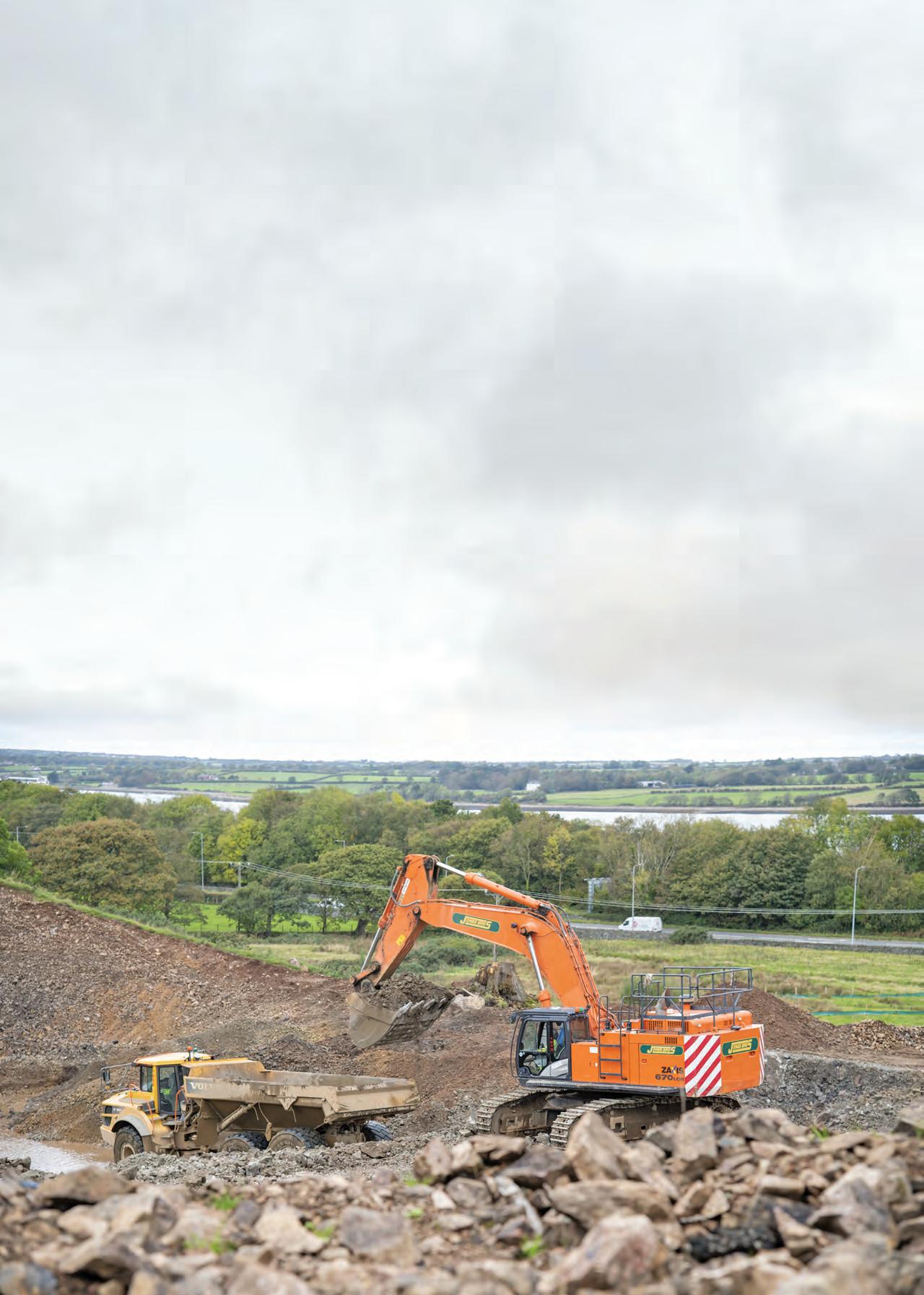
7 minute read
SITE VISIT
CIRCLING AROUND CAERNARFON CASTLE
Paul Argent reports on the construction of the long-awaited Caernarfon bypass, focusing on the fleet of machinery deployed by Jones Bros.
Advertisement
he historic North Wales town T of Caernarfon sits on the banks of the picturesque Menai Strait, on the main route from the busy A55 to the popular holiday destinations on the Llyn Peninsula. The A487, which runs through the centre of Caernarfon, can often become gridlocked, to the extent that the carriageway cannot be adequately maintained.
For many years there have been calls for a bypass, and the Welsh Assembly undertook an initial appraisal of the viability of such a scheme in 2008. With open water of the Menai Strait to the west of the town, circumnavigating Caernarfon’s eastern flank was always going to be problematic. In 2010 a favoured route was chosen, but was later changed due to budgetary constraints.
The contract was awarded in the winter of 2014 to a joint venture between Balfour Beatty and the Ruthin-based civil engineering contractor Jones Bros. This partnership has delivered a number of successful projects across Wales, including the Porthmadog bypass, just 20 miles along the coast. Following the next four and a half years spent in consultation with the local community and other stakeholders, work on the much-needed bypass started early in 2019.
PREPARATORY WORKS
The enabling phase of the project included large-scale tree clearance works along the route, for which
Jones Bros decided to buy a tree shear and a mulcher in preference to subbing it to a local specialist contractor.
Hefin Lloyd-Davies, Jones Bros’ project director for the bypass, said, “We decided to do this ourselves, as we didn’t have the permission simply to go from one end of the project to the other due to various nesting issues. This meant the machines would have to be transported back and forth to undertake small sections of work. If this was given to an outside contractor, we would have been hit by higher costs, whereas we were able to fit this in with other preparatory works.”
The 10km route across wet scrubland and farmland, bridges a number of roads, a railway and a river, and much focus was given to managing watercourses and constructing large structures (see panel overleaf). Hefin added that the early involvement of their structures subcontractor, R. Betts Construction, had helped immensely to keep the project running smoothly.

The northern section of the bypass requires a deep cut through hard rock, for which Jones Bros is using a Hitachi ZX870 excavator to load the freshly-blasted material.
FLEET FOCUS
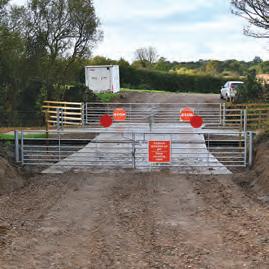
The undulating nature of the route will require a large amount of cut and fi ll works across the project. This work has commenced at a good rate, despite the poor weather, helped by Jones Bros deploying a number of large excavators.
The route south from the Goat roundabout fi rst crosses a steep rock escarpment, where weekly blasts are undertaken by the well-known specialist contractor EPC. The blasted material is loaded into a fl eet of ADTs by Jones Bros’ largest excavator, a relatively new 70-tonne class Hitachi ZX670.
This ZX670 was part of a large order from Jones Bros for Hitachi excavators, which included wheeled machines and tracked 21-tonne ZX210s, some of which were operating on the project. These Hitachis are operated, together with a number of recent 40- and 50-tonne class Volvos, in what has been an excavator fl eet historically dominated by Komatsu machines. The big Hitachi was working alongside a Komatsu PC360, the latter used to remove any oversized stone from the blasted material.
Both these excavators load a fl eet of Volvo and Komatsu ADTs, as Hefi n commented, “We took a number of the Komatsu machines a while back, to compare them to the Volvos. So far, they have been good trucks, but they aren’t as popular as the Volvos.”
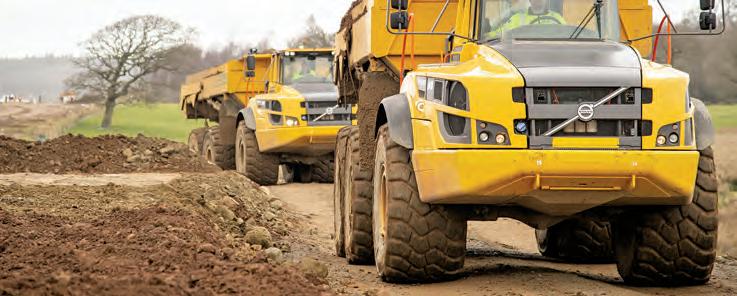
Material management was a key part of the project, for which temporary haul roads and bridges were constructed, and teams provided to manage any road crossings.
With a network of local roads along the route, a comprehensive traffic management plan was developed, which featured the construction of a number of haul roads. This was to ensure that all materials were moved within the site ands not on a public highway, although occasionally across one.
Hefin continued, “We have spent a lot of time and money looking at the viability of doing this. The construction of the haul roads and installation of temporary bridges will allow us to move materials at a far greater speed, increasing safety and productivity. We have traffic management on every temporary road crossing too. We control the lights to allow our trucks an unimpeded crossing. We also have personnel on hand to ensure that any mud dropped by the trucks is cleaned away before we allow the traffic to flow again.”
WET WATERCOURSES
The new bypass is a mixture of two- and three-lane sections, which runs from the Goat roundabout in the north, to the Plas Menai roundabout to the south of the town. Crossing nearly 10km of former scrub and farmland, the route calls for over 30 concrete structures, including two large viaducts. One these, the 280m Gwyrfai Viaduct, was not even in the original design package.
Anyone who knows this area will concur that it can be a wet part of the world. The route crosses an ancient floodplain, which today contains a huge number of watercourses, all of which had to be maintained, managed or diverted. While some of them were just small streams, others were much larger, requiring a serious amount of work.
One of these areas was at Gwyrfai. The
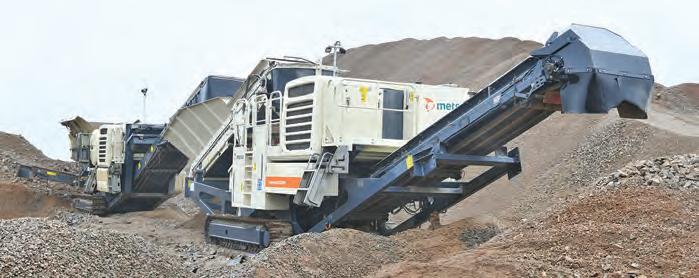
Jones Bros has deployed a large fl eet of machinery across the site, and the arisings from the rock cut are processed by sister company Cambrian.
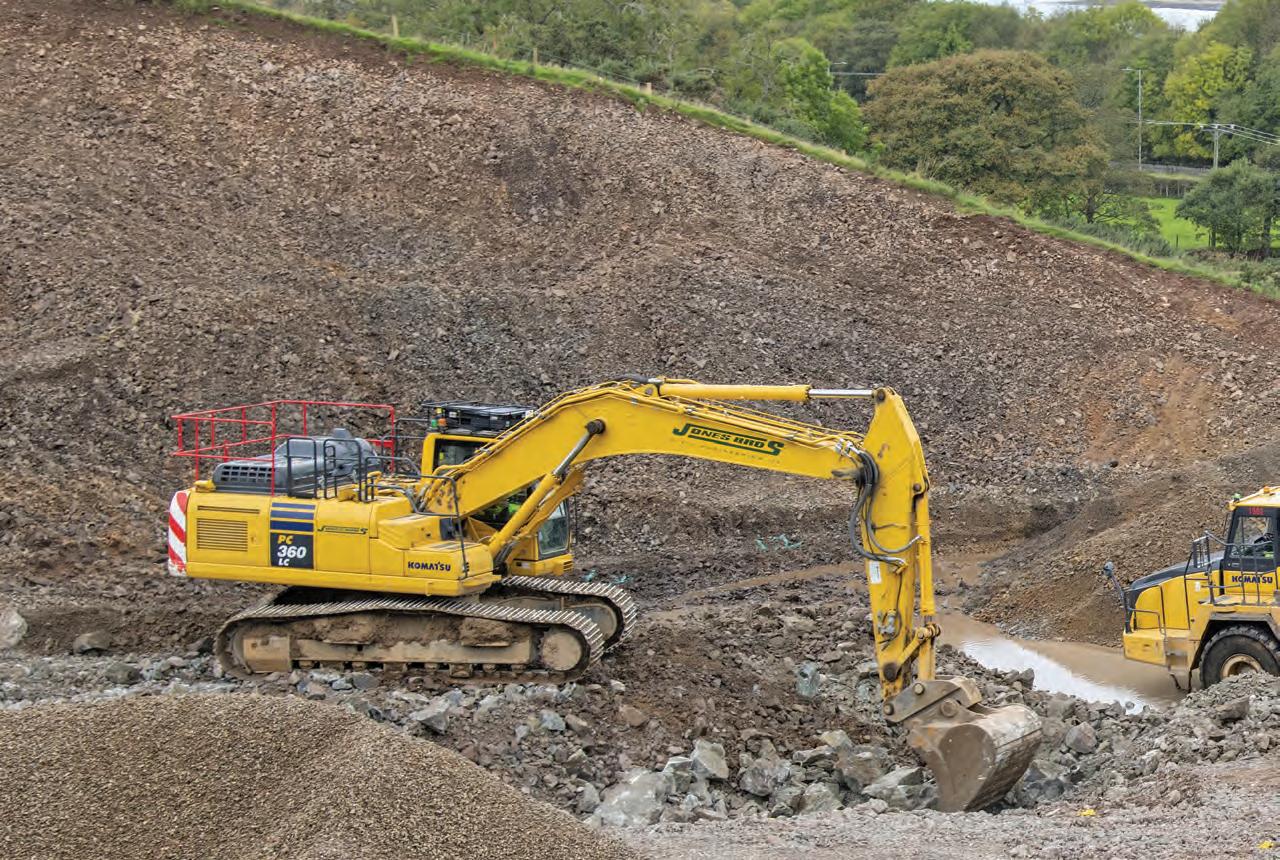
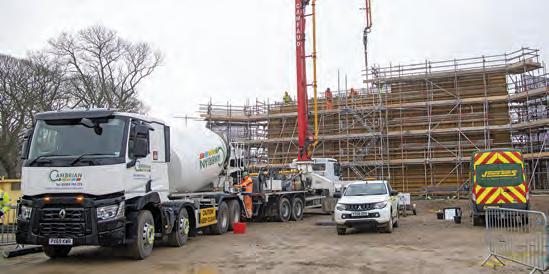
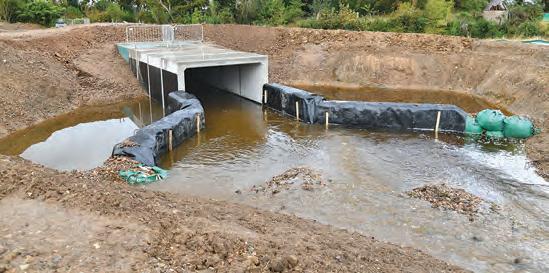
Left and above: The 10km Caernarfon bypass will include a high number of structures, both to manage the watercourses and to cross a river, plus a handful of roads and a railway line.
original design to manage the watercourse in this area was to construct a large bund, complete with large-diameter pipes through the structure. Unfortunately, it soon became clear that this was not sufficient, as at peak times the structure would not allow an adequate flow of water, leading to a risk of localised flooding. The redesign of the route along this section was over a low-height, large-span viaduct. The three-span structure, 280m Gwyrfai Viaduct allows more than enough water to pass beneath.
Other major structures include a 300m-long viaduct to take the bypass over the (river) Afon Gwyrfai, along with four bridges carrying existing roads either under or over the route, which also involves a crossing of the Welsh Highland Railway.
CONCLUSION
Jones Bros deployed a number of large excavators to this project, including the largest machine in their fleet, a Hitachi ZX670, which is currently engaged in an extensive rock cut on site (see panel). As the team hope for a spell of decent autumn weather to allow them to get ahead on the earthworks and concreting operations, the long-awaited bypass should be opened to traffic before the end of next year.
Clearly there is lot of work ahead of the joint venture team on this complex project, where good communication helps to keep everybody on track. Both Jones Bros and Balfour Beatty regularly hold ‘boots on the ground’ days, bringing together management, staff and supply chain representatives for briefings and training.
Although the construction of a bypass will bring significant benefits to Caernarfon, and despite measures to minimise the impact on the local community, actively engaging with local residents and business owners also helps to ensure the smooth flow of the project.
Hefin concluded, “We are always on hand to speak with the local community. It is far easier doing this, getting early approval and feedback.”
CAMBRIAN PROCESSING
In 2016 Jones Bros further diversifi ed with the establishment of the Cambrian business, which operates across three sectors: concrete, quarrying and stabilisation works. It included a signifi cant investment in Metso and McCloskey crushing and screening equipment, alongside a fl eet of McPhee concrete drum mixers, mounted on Renault chassis-cabs. Cambrian provides a mixture of services to this project in addition to processing all the rock from the cut. It also supplies all the concrete for the structures.
In addition, the new bypass skirts along the side of the former Peblig brickworks. Cambrian has purchased this site to provide a local source of blue clay, ideal to form the sub-structure of the bypass.












